7 Scholarships to Apply to in March
/A conveniently compiled list of 7 scholarships to apply to this March!
Read MoreYou Got Into Where? is a college admissions advice blog for high school students created by Joi Wade. Topics include the college search, SAT and ACT, college essays, the common application and college scholarships.
A conveniently compiled list of 7 scholarships to apply to this March!
Read MoreFind out how to make the most of your high school accomplishments using Raise.me to get micro scholarships. Getting a scholarship just got a whole lot easier! Through Raise.me, you can earn micro scholarships for your grades, extracurriculars, and other accomplishments that add up to thousands of dollars.
Read More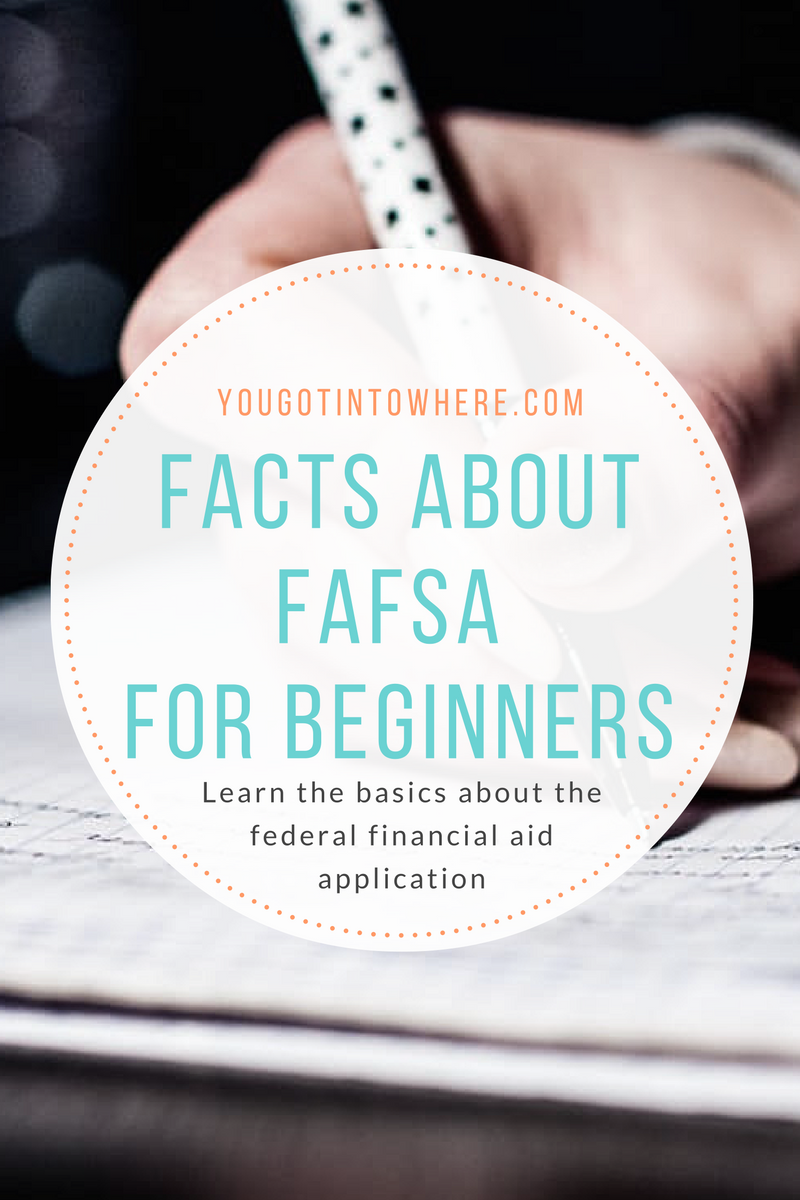
The FAFSA stands for Free Application for Federal Student Aid. The FAFSA is the form required at all colleges that accept and award financial aid. It’s the form that provides your college financial aid officers with the information they need to go ahead and create your financial aid package. The form helps determine the awarding of over $150 billion in federal aid, as well as state aid. To complete the FAFSA you’ll need to provide information from, in this case, your parents' most recent tax return, W-2’s and bank statements. (If your parents are divorced or separated, it’s based on the parent you spent the most time within the previous year). You must file a new FAFSA each academic year you want aid.
Every state has its own deadline for the FAFSA. Some states and colleges distribute aid on a first come, first-serve basis, so file as soon as you can. High school seniors should fill out a 2017-18 FAFSA as soon as possible. Wherever you live, you should check with your college guidance counselor to find out your college choices deadline for the FAFSA. The FAFSA gives you a full 18 months to file, so don’t worry if you’re late. This means that students who started college in the fall of 2016 can still file the FAFSA as late as June 30, 2017, and receive federal grants or loans.
Everyone is encouraged to apply. Low-income students who fill out the FAFSA typically receive full tuition from colleges if they come from disadvantaged backgrounds. Students, who do come from a low-income are still encouraged to apply; In some cases, the student’s family may be asked to pay a portion of the tuition if not full. However, students who are undocumented are not eligible for federal student aid. If the parents aren’t documented but the student is, you can still apply.
Now you know the important facts of the FAFSA. You know what the FAFSA stands for, when it’s due and who’s eligible to apply. Though all of this information may seem intimidating, don’t shy away from it. You never know what will happen.

Scholarships you need to look into starting in October
Are you a currently enrolled in an accredited college or university? Are you physically residing in the United States? Are you registered or have an account with Course Hero? Then this scholarship is for you. In four simple steps you can will a scholarship towards your education. All you have to do is make an account with Course Hero, give advice on classes you’ve taken, submit five original documents, and share on social media. That simple!
Do you plan to attend college but finances are a problem? No worries, apply to the College JumpStart Scholarship. The only requirements is to be current sophomore, junior, senior, college student, or non-traditional student and are/plan to attend a post-secondary institution. Answer one of the four personal statements on the application, which is being judged based on content not writing skills. Run over to the website and apply; it should take only 20 minutes.
Roses are red, violets are blue, you’re reading this article, and I thank you. Well, I’m pretty sure you can come up with a better poem than that. This scholarship is for those who are into creative writing (more specifically those who like poetry). Write a poem about what makes you feel good. All you have to do is go to the website and add your poem.

Do you want to go to college but money is an issue? Do you have a 3.0 GPA or higher? Well look no further! If you are a current senior in high school and you have minimum of a 3.0 GPA then you can apply to the Coca-Cola Scholarship. Explore the Coca-Cola Scholars page and look more into the requirements.
This scholarship is a tad bit on the weird side. You are taking your friend’s V-card. No not that V-card! Their voting card. You will help your friend register to vote. You’ll need to get on the website to find out all the little details.
The definition of weakness is: (A) lacking strength or (B) an attribute that is a disadvantage. Everyone has a weakness; everyone. My biggest weakness is my patience and temper. Don’t use your weakness as an excuse to not succeed. The Get Up! Get Active! scholarships allows students to identify your weakness and take action on how to solve them. You must be a high school or college student who is 15 years of age or older.
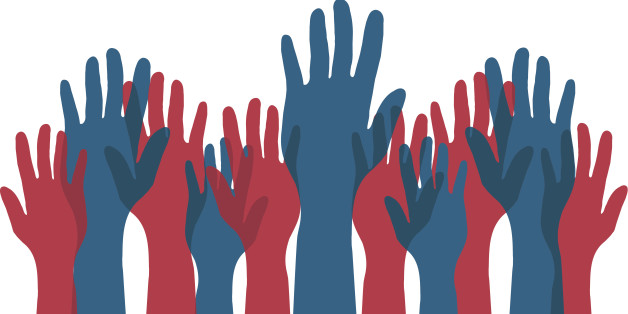
Are you patriotic? Do you love the United States of America? Is the Fourth of July your favorite holiday? Then you should apply to the Voice of Democracy Scholarship awarded by the Veterans of Foreign War of the United States. Use your public speaking skills and record yourself delivering a speech with the topic of “my responsibility to America.”
Do you have wonderful ideas to shape the world around us? Education is a major key to being successful in life. The Youth Noise Scholarship wants to hear what motivates you. You need to make a 2-3 minute video and upload it to YouTube. To submit it, you will need to send the active link, your name, address, and phone number through e-mail.
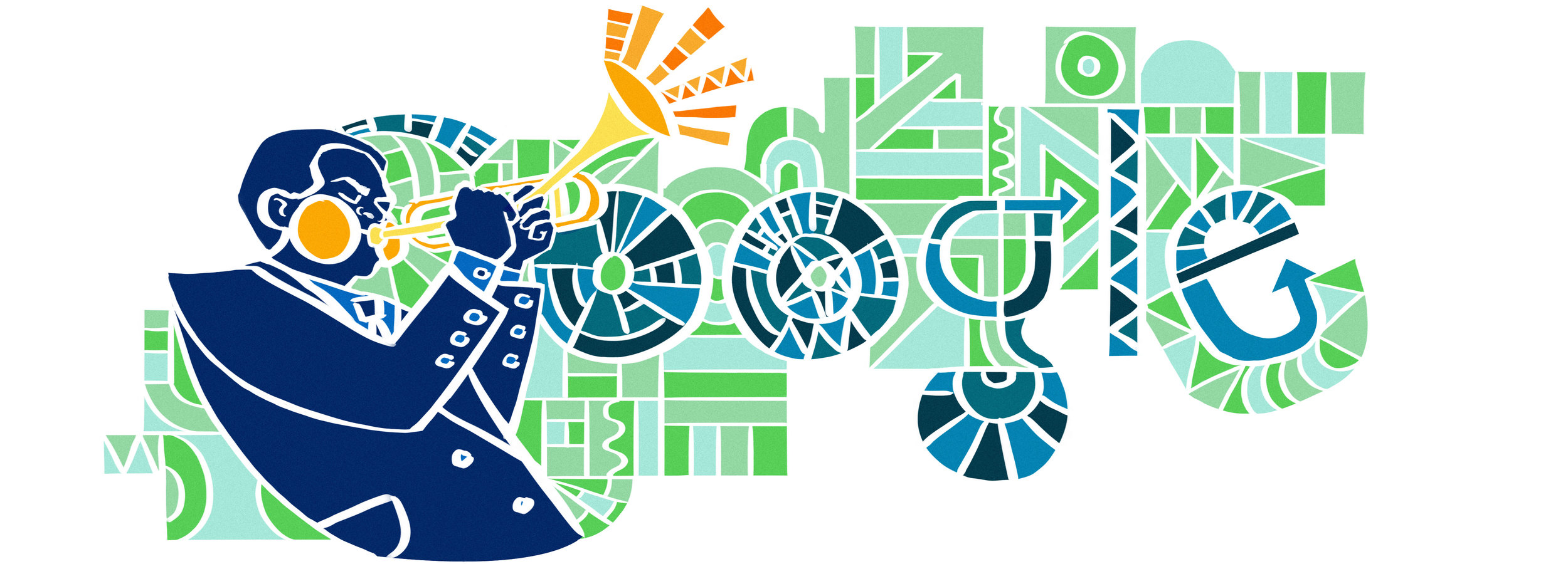
Is your imagination running 24/7? Do you find yourself randomly doodling in a notebook? Then you should take your artistic abilities and apply for the Doodle4Google scholarship open to students in K-12 who plan to go continue their education past high school. Each year, Google awards one lucky winner a scholarship and a feature on the Google homepage. Do you think you have what it takes? Grab your colored pencils and get the doodling.
Injustices of African-Americans, police brutality, gun control, immigration policies. These are all problems that the new POTUS has to handle. Although we might not have a say so in decisions, it will affect us all. That’s why you should apply to this scholarship. If you are tech savvy or you just know how to shoot a nice video then you should consider this opportunity. You must be in grades 6-12 and create a short, 5-7 minute, documentary with the theme of: “Your message to Washington: What is the most urgent issue for the new president and congress to address in 2017?”
Good luck on your search!
P.S. Don't wait to start!
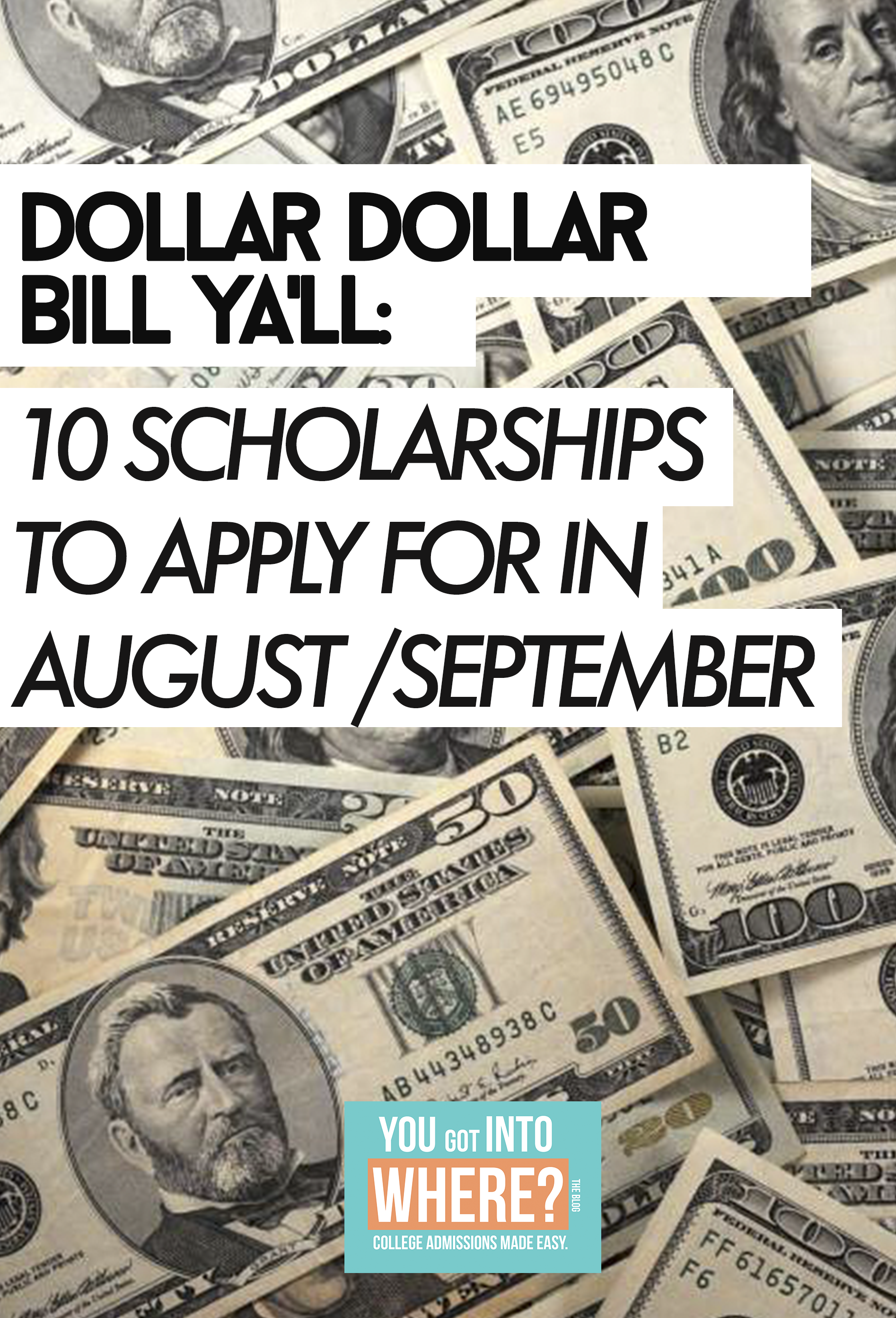
“We believe, that is, you and I, that education is not an expense. We believe it is an investment.” –Lyndon B. Johnston
Deadline: January 5th, 2017
Age/Grade: Middle and High School
The Young Patriots Essay Contest is designed to challenge middle and high school students to creatively engage with public policy and current events through the art of writing. We assign a controversial topic each year, and three winners are chosen to receive a scholarship out of hundreds of essay submissions. Find the topic and entry instructions below! "Are international free trade agreements in the best interest of the United States? Why or why not?"
Contest participants have the opportunity to: -Earn a college scholarship of up to $5,000 -Have your essay published on Debate Central -See your essay posted on the National Center for Policy Analysis (NCPA) home page -Have your essay shared with 200,000 NCPA Policy Patriots via email -Have your winning entry be sent to your hometown newspapers, radio, and TV
Essays must be written in English and should not exceed 1,200 words. A bibliography does not count towards the word total.
Deadline: September 30, 2016
Age/Grade: None
Citizenship Limit: US or Legal Citizen
Do you know how far you will drive on the freeway if you take your eyes off the road for five seconds, the average time it takes to send a text? An entire football field. According to the Virginia Tech Transportation Institute, texting while driving makes drivers 23 times more likely to get into a "safety-critical event." The purpose of this scholarship is to help you understand the risks of texting while driving. You must be a high school freshman, sophomore, junior, or senior or a current or entering college or graduate school student of any level. Home-schooled students are also eligible. There is no age limit. You must also be a U.S. citizen or legal resident.
We'll select the 10 finalists based on the content of the 140-character message. The winner will be selected based on the content and creativity of the 500- to 1,000-word essay.
Deadline: October 17, 2016
Age/Grade: 10th-12th
Citizenship Limit: US or Legal Citizen
The College JumpStart Scholarship is an annual, merit-based competition that is open to 10th, 11th and 12th graders and college students and non-traditional students. The goal is to recognize students who are committed to using education to better their life and that of their family and/or community.
Applicants must be 10th, 11th or 12th grade high school, college, or adult students. Applicants may study any major and attend any college in the U.S. Applicants must be legal residents of the United States and complete the online application form including the required personal statement. The award may be used for tuition, room and board, books or any related educational expense.
Deadline: October 5th, 2016
Age/Grade: High School and International Equivalent
All high school students and international equivalents are invited to submit an essay about the recent effects and future promises of science in our society. Write about particular discoveries, events, or persons from science in current events or present a more general account of the changes and developments. Each essay must be accompanied by a statement of acknowledged validity by a teacher in the field of the sciences, technology, engineering or mathematics.
Students must submit their essays and entry forms electronically on or before the contest deadline of October 8th.
Students who have family members affiliated with the Journal, or serving as contest judges are not eligible to participate.
This year's prompt: Albert Einstein once said, "To raise new questions, new possibilities, to regard old problems from a new angle, requires creative imagination and marks real advance in science." The scientific process has become increasingly interdisciplinary. Examine a modern issue in STEM being addressed from an interdisciplinary perspective and discuss the advantages and disadvantages of how these separate fields approach the issue and interact with each other. Potential topics could be found within many fields, including environmental science, engineering, and neuroscience. Note that originality is a substantial component of scoring.
- No literary form other than an essay will be accepted. - Each essay must reflect the contestant’s own writing and original thinking. - No graphs, images, or illustrations should be included in the essay - The essay must be sent via e-mail to dujs@dartmouth.edu with the subject line "DUJS ISEC SUBMISSION." - The Student Entry Form should be scanned and saved as a .pdf, .jpeg, or .png It must be attached to the email in conjunction with the essay. - Entries must be received on or before October 5th.
Deadline: January 4th, 2017
Age/Grade: Grades 9-12
Citizenship Limit: US Citizens only
The contest is open to United States high school students in grades nine through twelve (9-12) attending public, private, parochial, or home schools; U.S. students under the age of twenty enrolled in a high school correspondence/GED program in any of the fifty states, the District of Columbia, or the U.S. territories; and U.S. citizens attending schools overseas. Past winners and finalists are not eligible to participate. Employees of John Hancock Financial Services and members of their families are not eligible to participate.
Topic: Describe and analyze an act of political courage by a U.S. elected official that took place during or after 1956. Include an analysis of the obstacles, risks, and consequences associated with the act. The essay may concern an issue at the local, state, national, or international level.
Requirements: -Essays can be no more than 1,000 words but must be a minimum of 700 words. Citations and bibliography are not included in the word count -Essays must be the original work of the student. -John F. Kennedy, Robert F. Kennedy, and Edward M. Kennedy are not eligible subjects for essays -Essays must describe an act of political courage by a U.S. elected official that occurred during or after 1956, the publication date of Profiles in Courage. The official may have addressed an issue at the local, state, or national level Essays about past recipients of the Profile in Courage Award will be disqualified unless they describe an act of political courage other than the act for which the award was given. -Essays must have a minimum of five sources
Deadline: September 30th, 2016
Age/Grade: Ages 16-25 and have at least one year of secondary school left
Citizenship Limit: US and Canada only
In order to apply for the Odenza marketing group scholarship, you must first ‘like’ our Facebook page, and write two short essays. Every essay must contain 3 essential elements.
The essay must provide a thesis statement (in the introductory paragraph). The thesis statement must encapsulate the main argument for the paper. It must be clear and coherent, and it must answer the question that has been put forth by the application.
The essay must offer supporting evidence. The writer must provide the supporting evidence in paragraph (not bullet or list) form. Each paragraph must contain evidence that supports one idea or concept that proves the thesis statement. The writer must provide citations (in footnote, endnote, or parenthetical form) for all evidence presented.
Every essay must follow basic rules of grammar and format. Every paper must contain a beginning (introductory paragraph), a middle (several supporting paragraphs that compromise the body of the paper), and an end (conclusion paragraph). Grammar is vital for essay composition. Sentence fragments, misspellings, and improper punctuation denote a carelessly-written and poorly-conceived paper.
Deadline: September 30, 2016
Age/Grade: 17+ and enrolling in college within 12 months or already enrolled
Citizenship Limit: US Citizens
Scholarship is open to U.S. citizens and legal residents who are starting a program of higher education (college or graduate school) within the next 12 months or are currently enrolled. Applicant must be 17 years of age or older and there is no maximum age limit. Applicant must share in three sentences of less why they are getting their degree.
Deadline: September 30, 2016
Age/Grade 13+ and will enroll no later than 2022
Citizenship Limit: US Citizen
Scholarship is open to students 13 years of age or older who are legal residents of the 50 United States or the District of Columbia and are currently enrolled (or will enroll no later than the fall of 2022) in an accredited post-secondary institution of higher education. Applicant will need to submit a short response to a given prompt.
Deadline: September 30, 2016
Age/Grade: High school seniors and college students
Scholarship is open to high school seniors and college students enrolled in an accredited academic institution. Applicant must submit an essay on the most interesting item they have received in the mail.
Deadline: September 20, 2016
Age/Grade: Grades 9-12
Competition is open to individuals and teams of up to three students in grades 9 through 12. Students are encouraged to do research in mathematics, engineering, biological, or physical science.

Just because guidance counselors don’t wear tights and a cape doesn’t mean they can’t save the day by helping you with high school survival and college prep.
Real Talk: High school is hard. Between studying for tests, completing homework, trying to keep a social life, and preparing for the next big stage of your life (hint: college), high schoolers are lucky if they manage to remember what the cafeteria is serving for lunch (bonus points if you remembered what the cafeteria was serving, and then remembered to pack a bag lunch). Your parents don’t always understand what you’re going through, your friends are too busy with their own workload to commiserate over the size of yours, and your dog, while comforting, does not keep an interesting conversation. Well, now your dog can stop working overtime as your therapist because there is someone whose job is to help you with each and every high school problem you encounter: your guidance counselor.
Don’t roll your eyes just yet. I use the term “guidance counselor” loosely, because in actuality, they are superheroes here to save your day from overbearing class schedules, toxic friendships, and general college prep procrastination. Their super powers include gaining access to scholarships you didn’t even know existed, switching you out of the science class taught by that crazy teacher (...you know the one), and seeing the potential in you before you learn to recognize it in yourself.

So, how do you gain access to these men and women wearing invisible capes? You ask. Notice how the word “you” is bolded. Guidance counselors are happy to help you, in fact they want you to succeed, but they are not going to save you from the burning building that is your crazy teacher (you know the one) kicking and screaming. No, in contrast to your parents, your guidance counselors will not nag you to apply for scholarships, take AP Chem, or apply to your dream school. You have to have the self-motivation to reach your goals, and you have to ask your guidance counselors for help in reaching them.
Once you ask for help (no, the word “you” will not be bolded for the rest of this article), your guidance counselors will channel Clark Kent and spring into action (outfit change optional). Is it a bird? Is it a plane? No, it’s just your guidance counselor working their butt off to help you have a bright future. Your guidance counselor can help you make sure you have enough credits to graduate, that the rigor of your classes is right for you, and you are taking the type of classes colleges look for. As mentioned before, your guidance counselor also has access to information about many scholarships, and can help you find the right ones for you. Your guidance counselor can also nominate you for scholarships your teachers or supervisors can’t (hello, the Presidential Scholarship). Your guidance counselor can also help you figure out your passion, and what career you may want to occupy by taking interest tests, directing you to job fairs, and even getting you in touch with career coaches to guide you. Also, many colleges are now requiring letters of recommendation from your guidance counselors. So, the sooner you get to know your guidance counselor, the more he/she can help you.

But you are not the only student these superheroes rescue on the daily, the other students in your school use the help of the guidance counselor as well. Depending on the size of your school, your guidance counselor may be the most accessible person on the planet, or they may schedule your appointment three months out. Whatever the case, your time with them is precious, so here are some questions that can help you get acclimated with what your cape-less hero can do for you:
No matter your age, college is right around the corner and it is never too early to start planning. Your guidance counselor can help you get in touch with sports coaches, direct you to clubs that fit your interest, or help you connect with a teacher who needs someone to help them with research. If there are no activities at your school that you are interested in, your guidance counselor will help you start your own club!
Not only does this give you and your guidance counselor a chance to fix any mistakes that may have been made, but it also opens the door to a conversation about the classes you are taking, if there are any classes you should be taking, and if you have enough credits to graduate with your class.
Your guidance counselor will tell you whether you should take the SAT, the ACT, or both. They will also give you information on how to sign up for the tests, when the tests are being given, where the tests are being given, and the prices of testing. If you are unable to pay to take the tests, your guidance counselor can help you figure out a way to still test. Also, if you are young enough, your guidance counselor may recommend taking the practice ACT and SAT, and will have information about those as well.
Depending on your age, the answer will differ, but I can guarantee the answer will never be “no.” If you are a freshmen, there is always a new class to try, new activities to join, new passions to discover! If you are a senior, even if you think you are on top of your applications, there is always something more you can do to get extra scholarship money and improve your chances of being accepted. How do you do this? I don’t know, ask your guidance counselor.
At the end of the day, the help your guidance counselors give you is what you (last bolded “you”, I promise) make of it. You can either go back to puttering around on the internet while simultaneously putting off your math homework (I see you), or you (I lied) can take their advice, hustle, and make the most of high school. Don't play damsel in distress in your own success story when you can be an ally to your own academic achievements.

Finding relevant scholarships can be a challenge; anyone who’s spent more than five minutes searching for one can tell you that. There are numerous scholarship search websites that boast about having millions of scholarships worth billions of dollars in total and that they’ll match you with the perfect ones just for you, but do they actually work? Are your scholarship matches really individualized? How many of those millions of scholarships can you actually apply for? To find out, sign up for six of the most popular free scholarship websites. I filled out each profile as thoroughly as possible in order to get the most relevant matches, listing three different majors (journalism, biomedical sciences, and mathematics) for each website, so as to distinguish between a website not having major-specific scholarships and there not being many scholarships for a specific major.
After a week, here, in no particular order, are the results:
Number of Matches: 51
I’d used Fastweb before as a college search engine, but never to search for scholarships. Every time I would open the website, their main page would always boast about their more than 1.5 million scholarships and how their system targets the perfect scholarships for you based on your interests and skills, so I had high expectations. After filling out my profile, I was matched with 49 scholarships, most of which were pretty general. I only found 3 scholarships that correlated with the majors I put in my profile, but most of the others were ones anyone willing to write an essay or create a short video could apply for. These scholarships seem to be based primarily on age, though the ones I was not qualified for based on my profile were eliminated, so I didn’t have to do a lot of voting through. These types of scholarships are great if you do not know what you’re majoring in or you aren’t super passionate about anything, and if you want to apply to a large quantity of scholarships that don’t require pages and pages of essays.
At the end of the week, I had 2 new scholarship matches, so it seems that their website is updated quite often.
Conclusion: While most Fastweb’s scholarships may not be individualized, it is nevertheless a great resource for scholarships, especially for those who don’t know their major.
Number of Matches: 39
Cappex is primarily a college search website, and, from what I’m told, is a pretty good one, but it also has a section for scholarships, which sounded very promising. Despite my rather thorough profile, the scholarships I matched with on Cappex weren’t at all individualized; I didn’t find a single one that correlated with the majors I entered in my profile, unless you count the FeetRemedies.com Scholarship on plantar fasciitis for biomedical science. Like Fastweb, it seemed I was matched with scholarships based only on my age, taking nothing else into account. This can actually be a good thing, as I previously explained, but unlike Fastweb, some of the scholarships I matched with I could not apply for because I was simply ineligible for them. Whether it was because I was not a returning college student or a resident of Texas, these scholarships could have been weeded out easily using the information in my profile. The remaining scholarships I was eligible for were of quality, but they could also be found on Fastweb, which had a few more than Cappex did as well.
Conclusion: Although it may be a good college search website, I found it to be a mediocre scholarship search website.
Number of Matches: It’s Complicated
Raise.me is a bit different from your typical scholarship searching website. Instead of matching you with scholarships that you then have to apply for, you are awarded with micro-scholarships from different schools based on your achievements in high school: $500 for each A you get, $200 for having perfect attendance, $10 for every hour you volunteer, and so on. You’ll receive more or less money from an achievement based on the school, as some schools are more focused on community service or extracurricular activities more than others. The most money I received from a school was $70,150 ($17,538 a year) and the least was still $1,455 ($364 a year). It all seems a little too good to be true, and, depending on your preference in schools, it is. Of the 130 schools offering micro-scholarships, most of them are small, liberal arts schools; only 38 schools on the site have over 5000 students, and there aren’t exactly any big name schools. Most of the schools I received micro-scholarships from were from schools I had never heard of in cities I had never heard of. So, while I would definitely give Raise.me a chance, if you know you want to go to a large school or an Ivy League university, it may be best to look elsewhere.
Conclusion: Fantastic for small liberal arts schools and a few large state schools.

Number of Matches: 120
To my complete surprise and excitement, this was the first scholarship search website I visited that actually took my profile into account when matching me with scholarships. The scholarships I was provided with fit not only my majors, but also a few other factors listed in my profile such as my religion and high school activities. While I was matched with a few seemingly random scholarships like the ones for PlumbersStock.com and the Maine Grocers & Food Producers Association, most of them either matched my interests or were just generally geared towards all students my age and only required an essay, both of which are things I want when applying for scholarships.
Conclusion: By providing largely relevant scholarships with varying degrees of difficulty, Scholarships.com is a fantastic resource and lives up to its’ name.
Number of Matches: 194
The College Board website is one many high school students are familiar with in some capacity, mostly from viewing scores for the SAT, the PSAT, and any AP tests, but it also can be used to search for scholarships. Although it matched me with the most scholarships in total, I was not able to apply for many because they were either past the deadline or I was just ineligible. I did, however, get matched with scholarships that were relevant to my major, but not to anything else; it seemed this was the only website that did not take my age and high school status into account when picking scholarships for me. They only provided a few general anyone-in-high-school-can-apply scholarships: most of their scholarships had specific qualifications such as race, religion, and membership to an organization that I did not fulfill, making me wonder why they were presented as options to me in the first place. All that being said, the scholarships specific to the majors I put in my profile were pretty fantastic on a monetary level and, as a whole, not that difficult to apply for.
Conclusion: Can provide one with great scholarships relevant to their major if they are willing to comb through the ones they’re ineligible for.
Number of Matches: 86
When I began looking into different scholarship sites, I had a bunch of people tell me that should sign up for Zinch because they either read an article about it or knew someone who used it. So, sure enough, I typed in Zinch.com and was redirected to a site called Chegg, which specializes in textbook rentals. Thinking I had typed it in wrong, I tried again, but it still came back to Chegg. I soon came to realize that Zinch had been bought out by Chegg in 2011 and their scholarship section had been moved to the last to the last section of the last tab on the homepage. I was curious to see if, despite this major status downgrade, the famed scholarship search engine still lived up to its’ name.
I was matched with scholarships on Chegg based solely on my age and year in school, which at this point I’ve come to expect and appreciate in some ways; however, a little over half of the 86 scholarships I was matched with I was ineligible for. Attached to each scholarship were little tags that showed what aspect of my profile it matched: my age, year in school, or sometimes, my citizenship. These tags only graced 37 of the 86 scholarships I matched with, and the rest I was not eligible for because of my age, year in school, or citizenship. The scholarships I was eligible did have a wide range of participation levels, ranging from collecting peanut butter for a food bank to writing an essay about how collecting peanut butter for a food bank can affect your life. Community service was a common theme among many of the scholarships I matched with, which gave the website a bit of a flair in my opinion, as many of the scholarships I looked through over the week were more about academic achievement.
Conclusion: Not sure it lives up to the glory of its’ original name, but it proved it deserves more than being the last section of the last tab.

A few months ago, I remember receiving an email from Ana McCullough titled, “An invitation from Questbridge.” Admittedly, I simply selected it and marked it as read, as I do with all of my college emails. However as time passed, I continued to receive more and more emails from Questbridge inviting me to apply, so I finally clicked the link. That is when I learned about the College Prep Scholarship program. On their website, I discovered the plethora of resources they were offering to students who were awarded their scholarships: counseling with college essays, full rides to pre-college summer programs at top universities, and more. I did not end up applying to the program however, and it is something I regret as I begin my college application process.
Questbridge was created by Stanford students as part of an initiative to increase student outreach. Their mission is to help high-achieving, low-income students learn about a myriad of opportunities available to them by assisting in their application process to top universities partnered with the organization. In addition, they offer a variety of resources on their website for everyone to use such as tips for writing a college essay and using the low-income strategy. Questbridge offers three main services: College Prep Scholarship Program, The National College Match, and The Questbridge Scholars Network.
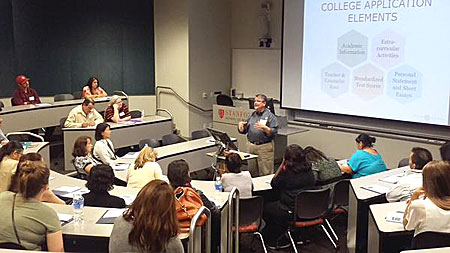
The College Prep Scholarship program is targeted at low-income, high achieving, high school juniors. The application opens in mid-February and is due in the last week of March. It includes a very extensive application that requires personal information, financial background, academic records, letters of recommendation, personal essay, short answer responses, and an activities list. Even though a lot is required of applicants, the benefits for the scholarship winners are endless.
As the name suggests, the program offers rising seniors with college preparation resources. Members will receive the opportunity to attend Questbridge’s annual conference to sit in on exclusive presentations by admission counselors. Students who previously had not thought of applying to a selective college often leave the meeting inspired after learning about the generous financial aid offered by top colleges and the large support system waiting for them at these universities.
The essay used for the application will be used for college applications and will be reviewed by a college counselor for free, a service that can cost up to thousands of dollars, and is otherwise unattainable for low-income students.
Another major component of this program is full-rides to attend pre-college summer programs at these prestigious universities, including Stanford, Columbia, UChicago, to name a few. Students are able to earn college credit and experience learning in a college environment while still in their high school years, something that low-income students would not have the chance to experience otherwise.
In addition, admitted students are able to receive information throughout the year regarding topics such as fly-in programs, mentoring programs, and will have the opportunity to apply for Quest for Excellence awards.
While the application may seem daunting at first glance, if you start early and work step-by-step without procrastinating, you will complete it in time. If accepted you will be able to meet with a community of people who have gone through significant challenges in life, and you will be able to have them as a support group for your college admission journey and beyond.

The National College Match is a program targeted at rising high school seniors. The application opens in June and is due in late September. It is very similar to the application used for the College Prep Scholarship, in fact, you even have the option to reuse its application for this program. The National College Match helps high school seniors apply to college and gain admission to top universities by providing them with a free application that is able to highlight the strength of their accomplishments in regards to their circumstances. This program offers opportunities for low-income students to be recognized in the same light as their competing peers.
After submitting the application, members have up to mid-October to rank Questbridge’s partner colleges from 1-12, 1 being your top choice and 12 being your last, of course you don’t have to fill all 12 spots, you could even only submit 1. Ranking colleges means that these are the colleges you want to be considered for admission with a college match scholarship which provides a full-ride for all four years of college. While all partner colleges provide students with scholarships to fulfill 100% of demonstrated financial need, the college match scholarship eliminates the need to fill out FAFSA and the CSS profile every year. However, with the exception of Stanford, MIT, Yale, and Princeton, the college match is binding, meaning you have to attend no matter what. You will only be matched to the school that is higher up in your list that wants to offer a match. (Say the University of Pennsylvania is your second choice and Trinity College is your fourth and both schools are interested in providing a college match scholarship, you will only be matched to the University of Pennsylvania). Students will receive notification of their status in the first week of December, students who do not match have the option to apply early action/decision or through regular decision.
To some students, this may seem as a high degree of commitment, therefore some finalists opt to not enter the match, but rather choose to apply through Regular Decision. Applying through regular decision allows them to apply to partner colleges for free, and are still able to receive a generous financial aid offer, and are able to compare offers if admitted to more than one. If admitted to a partner college either through the match or regular decision, students gain access to the Questbridge Scholars Network, a community of scholars to guide you through college and other elements of it such as internships, to help you succeed through it.
Bottom line, applying to the National College Match does NOT guarantee admission to a partner college, in fact most students are not admitted. However, there is nothing to lose from applying. You are granted the opportunity to begin applying to college two months before applications even open on August 1st. By September, you will have everything needed for your other non-Questbridge college applications, minus the supplements. Even if you are rejected, you almost have all the materials needed to apply to schools through the Common Application. And of course, there’s also the chance of being selected as a finalist, and even admitted to a top university.

Once a student commits to a partner college they become a member of the Questbridge Scholars Network chapter at their respective college. The QSN will send information about internships and grants throughout your college career to help ensure each student's success. In addition, the chapter serves as a support group, preventing students to drop-out as a result of unforeseen pressures and stress, allowing them graduate in four years, and helping each other overcome the hardships that come being a low-income, first generation college student.
I encourage all students to read more information about Questbridge and their many programs offered. Every year, low-income students are given a once in a lifetime opportunity to attend a top university for free.

August 1st has come and gone, which means that college application season is now in full swing. As students across the country decide which schools they want to commit four or more years of their lives to, the subject of money weighs heavily in the back of their minds and influences where they apply. It’s no secret that a higher education puts a dent in your pocket, but knowing what financial aid options you have can make it less severe.

The Free Application for Federal Student Aid (FAFSA) is the most common form of financial aid. In fact, most colleges require students to fill it out so that they can be considered for the schools’ own merit or need-based scholarships and grants. Depending on your financial situation, the FAFSA might do a lot for you, or barely anything at all- still, even if you think that you don’t qualify for aid, you should still file, because you’ll never know what you might get until you do.
Two big changes have been made for the 2017-2018 application cycle: one, you can use your income information from 2015 instead of 2016, and two, the FAFSA will be available on October 1st, 2017, which is the earliest it’s ever been accessible. So, mark your calendars and when October comes around, make the wise choice of filing your FAFSA. For more information, check out this website.
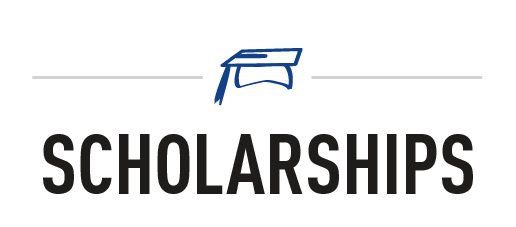
Scholarships are probably the most obvious form of financial aid, but many students wait for scholarship opportunities to find them instead of taking matters into their own hands. It is better to be proactive throughout the coming months by researching what you are eligible for first on a local, then national scale. Make sure to talk to your counselor for assistance. If you want more insight into how to find scholarships, check out Joi Wade’s post, How to Get Scholarships for College!.
These programs are not often talked about, so here’s the scoop: by being a part of one of them, you can pay in-state tuition at an out-of-state school. For example, when participating in the Southern Regional Education Board’s Academic Common Market, a student who is a resident in South Carolina can get the in-state tuition at colleges in many other states, from Georgia to Alabama to Maryland.
Be wary of these programs, though; it is usually the case that someone is only eligible to take part in them if their major is not available in their home state. Learn more here.

Whenever the word “loan” is mentioned, students and parents alike get a bit uneasy. The thought of graduating with debt to pay back for years to come is unsettling for most people, but there are multiple options for loans that you can research. It is recommended that you apply for federal loans before searching for private ones, with the most popular being the Stafford and Perkins loans.
There are two different types of Stafford Loans: subsidized and unsubsidized. The subsidized Stafford Loan is available to students who qualify for aid based on the FAFSA, and interest that accrues is covered by the government until six months after the student leaves school. The unsubsidized Stafford loan is available to any student who has filed the FAFSA, regardless of need, but interest payments are the students’ responsibility from the get-go.
The Perkins Loan is for students with exceptional financial need. The student’s school acts as the lender, using funds provided by the federal government, which also pays the student’s interest throughout their college career. Not all schools are a part of the Perkins Loan program, so it would be wise to contact the schools you apply to so you can verify their participation status.
For more information on these loans and others, check out this website.
Hopefully by knowing your options for financial aid, you will feel more confident about paying for your higher education, and won’t be deterred from applying to certain schools simply because of their price tag! Remember that these are not the only options and just a few to get you started. Always talk to a trusted family member about all of your financial options for paying for school.
If you are in high school, your parents may be pushing you to begin looking for extra money to pay for college. The realm of scholarships is large and confusing and some people find themselves overwhelmed and then give up applying. Here are my top five tips for getting scholarship money for school.
Read MoreYou Got Into Where? is a college admissions help website for high school students who want admission and scholarships to their top-choice universities. Get help on the SAT and ACT, college essays, the common app, scholarships and more.

Searching for transparent posts from a student's perspective on how to search and apply for colleges AND get scholarship money? You've come to the right place. Learn more...
Privacy Policy - Terms of Use - Jobs & Internships
Copyright 2018 | You Got Into Where? by Joi Wade